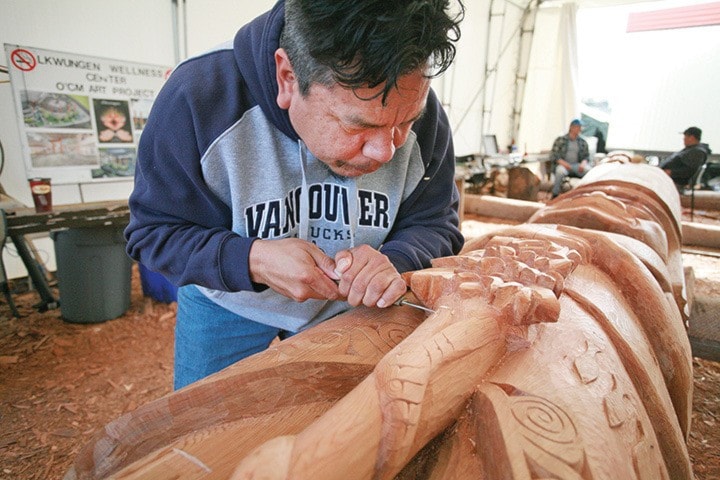Songhees Nation carver Clarence Dick is working with other carvers in his community to develop a distinct Songhees carving style.
He’s quick to point out Coast Salish people are more known for carving house posts, not totem poles. The difference, he says, is a totem pole is round and a house post has a “flat back with a high relief carving on top.”
Showing an octopus carved on a house post for the proposed Songhees Wellness Centre, Dick shows how the tentacles curl out of sight, making it appear the sea creature is sitting on the post, not carved out of it.
“On house posts we are carving on the sides and underneath to make it have a 3-D look,” Dick says. A traditional Coast Salish house post would have flat sides, he adds.
This is one of the techniques setting Songhees carvers apart from others.
Dick has been carving full time for the wellness centre project since May 2010 and expects the project to be completed next January. He and two other carvers are creating five 20-foot house posts, two totem poles with a connecting centrepiece and a 27-foot loon ladle. “None of us have ever done anything like that before,” Dick says.
In keeping with tradition, he uses authentically Coast Salish designs and shapes, including crescents and trigons. “This is a blend of old traditions with a modern twist. We are trying to develop a distinct style for Songhees to leave our own legacy behind.”
Dick and the other carvers are putting a modern flare on these massive carvings, but ancient traditions are reflected as well.
“Everybody is going from old museum archives and old photos,” he says, explaining how novice and veteran carvers study to improve their art form. “A lot of people’s work looks similar because they are studying the same carvings.”
It’s not only Songhees carvers who go to the Royal B.C. Museum to study ancient carvings.
“We get artists from all across the province coming,” says Martha Black, the museum’s curator of ethnology. “The Songhees are always welcome, as we are on Lkwungen land.”
Black sees similarities in work from carvers and from communities, but says there is no set style for the region.
“It’s a living thing, it’s not static. It’s a living cultural heritage. I don’t see one Bella Bella style, I see several and they are all from the same community.”
